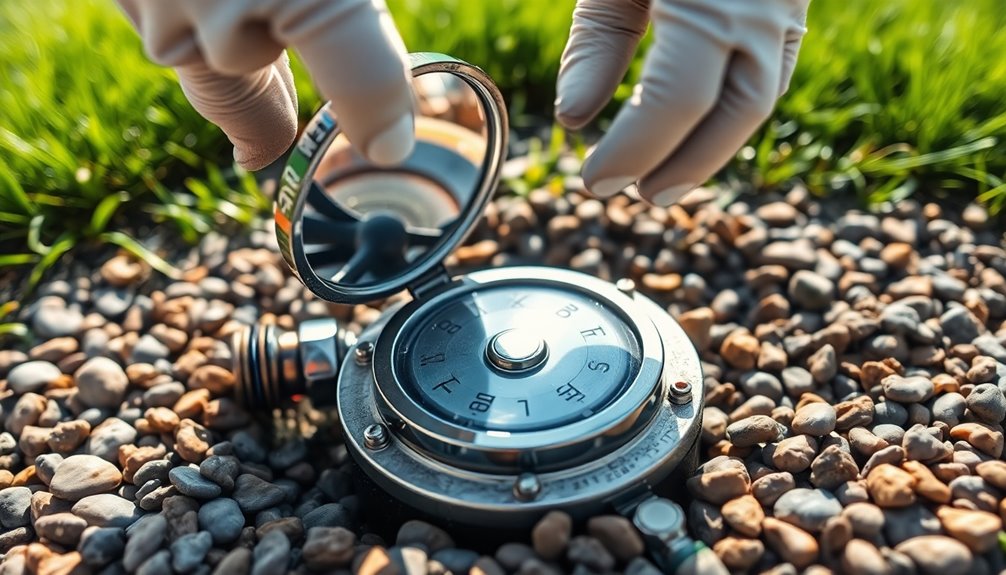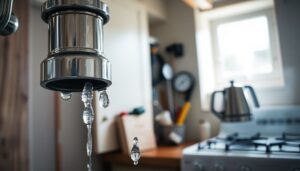To find your water meter, check common locations like basements, garages, or outdoors near entry points. You might need a flathead screwdriver, flashlight, and gloves to access the meter safely. Regularly monitoring your meter helps you spot leaks early, which can prevent high bills. Consider installing water-efficient fixtures and fixing leaks promptly to cut down on usage. Additionally, you can schedule regular inspections with your utility company, as they often offer free checks. These steps can greatly lower your utility costs, and there's more valuable insight on optimizing your water usage waiting for you next.
Importance of Knowing Your Meter
Knowing the location of your water meter is vital for effective home management. By knowing where it is, you can regularly monitor your water consumption, helping you spot leaks before they turn into costly surprises on your utility bill. Regularly tracking your expenses enables you to allocate funds effectively and identify areas for potential savings.
Taking the time to read your meter frequently provides insights into your usage patterns, allowing you to make informed decisions about how to reduce waste. Familiarizing yourself with your meter also aids in detecting unauthorized water flow, such as theft. Regularly monitoring your water usage helps you establish a routine for checking alerts that can prevent unexpected spikes in your bills.
If you notice an unexplained spike in water consumption, it's important to address it promptly. Regular meter checks empower you to catch these anomalies early, potentially saving you money on unexpectedly high bills. By leveraging tools for expense tracking, you can effectively manage your overall utility costs.
Understanding how to read your meter guarantees you're billed accurately based on your actual water usage. Instead of relying solely on estimates from your utility provider, you can track your consumption with confidence. This knowledge not only helps you manage your budget better but also encourages responsible water use in your home. By keeping tabs on your water meter, you take control of your water consumption and protect yourself from unwanted expenses. Additionally, regularly reviewing your financial goals can enhance your ability to allocate funds for home maintenance and utility costs efficiently.
Common Water Meter Locations
When you're looking for your water meter, start by checking common indoor spots like the basement, garage, or utility room. If it's outside, you might find it in a protective box labeled "water" or even in a transparent enclosure. Additionally, knowing how to track expenses with expense tracking apps can help you monitor your utility costs more effectively. Budgeting apps can also assist in organizing your overall spending, including utility bills. Keep in mind that it could also be hidden along your property line or in a utility easement, so be thorough in your search. Additionally, using an app with receipt scanning technology can help you track your utility expenses more effectively.
Typical Meter Placement
Many homeowners find their water meters tucked away in specific locations that make them easy to access for readings and maintenance. Generally, water meters are close to the main water line entry point of your house. You'll often discover them in basements, garages, or utility rooms.
Here are a few common placements to keep in mind:
- Inside basements or utility rooms
- In garages near the main water line
- In outdoor boxes labeled "water"
Some meters might be housed in transparent boxes that let you see the reading without lifting a lid. However, the exact location can vary based on your property layout and local regulations.
If you're having trouble finding your water meter, don't hesitate to contact your water company for assistance.
Regularly checking your water meter is essential for monitoring your usage and detecting leaks. By staying informed about your water consumption, you can take steps to cut down on utility bills and manage your water usage effectively.
Outdoor Meter Locations
Where might you find your outdoor water meter? Typically, it's located near where the main water line enters your property.
You'll often find it in your front yard or close to the curb for easy access by utility personnel. The meter usually resides in a box labeled "water," which is made from metal or plastic to protect it from the elements.
Check for a transparent or clear cover on the box; this can allow for quick visual inspections without needing to open it.
If your meter isn't easily visible, it might be buried or in less accessible areas, like basements, garages, or utility rooms, depending on your building's design and local regulations.
If you're still having trouble locating your water meter, don't hesitate to contact your water company. They can provide detailed guidance and help you find your meters more easily.
Knowing where your water meter is can help you monitor your usage and potentially cut down on those utility bills.
Types of Water Meters
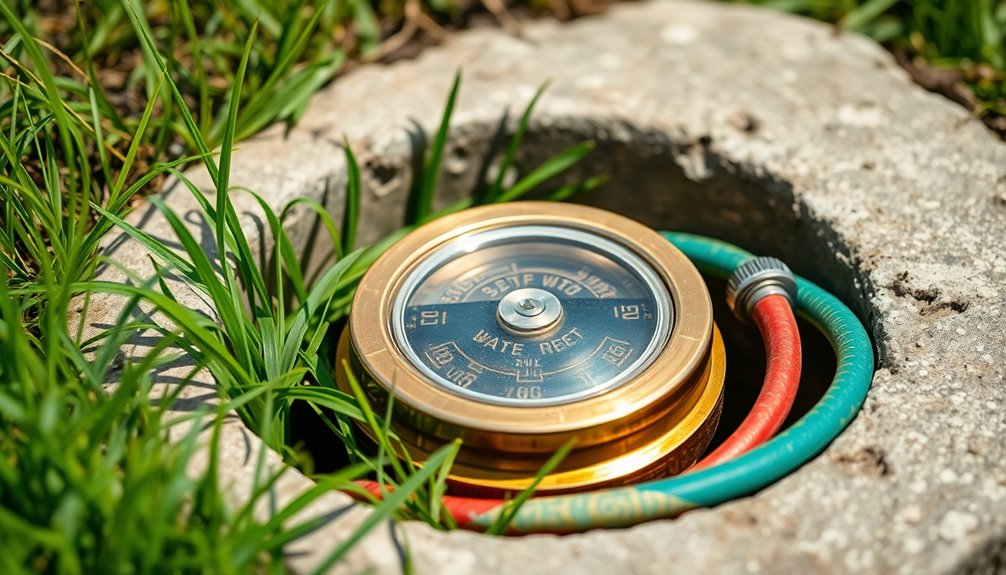
Understanding the types of water meters available can help you choose the right one for your needs. Water meters generally fall into two categories: digital and mechanical.
Digital meters offer automated reporting and allow you to track usage via mobile apps or websites, making it easier to monitor your consumption. On the other hand, mechanical meters require manual readings, which can sometimes lead to estimated monthly bills.
Here are some key differences between the two types of water meters:
- Digital Meters: Feature displays showing total water usage and flow rates, enhancing ease of use. Additionally, AI-driven tools can optimize your consumption habits based on usage patterns. These tools can also provide real-time insights into portfolio performance, helping you manage various expenses more effectively.
- Mechanical Meters: Use analog dials that may be less straightforward, requiring careful attention to detail.
- Accuracy: Digital meters often employ advanced technologies, like ultrasonic measurement, to reduce errors from interference.
Locating your water meter is essential, as it's typically near the main water line entry. Many modern digital meters can also integrate with expense tracking tools(#) that help you manage your utility costs effectively.
Regularly checking your meter can help you spot unusual spikes in your bills. By understanding the types of water meters and how to read your water meter, you can take control of your water usage and potentially lower your utility bills.
Tools Needed to Access Your Meter
To access your water meter effectively, you'll need a few essential tools.
Gather items like a screwdriver, flashlight, and gloves to guarantee safety and ease of access. Additionally, using a budgeting app can help you track expenses related to your utility bills, allowing for better financial management. Having a budget app can also assist in monitoring cash flow to ensure you stay within your financial limits. Furthermore, utilizing budgeting apps can enhance your financial control by providing insights into your spending habits.
Depending on your meter type, having pliers and a notepad or mobile device handy can also make the process smoother.
Necessary Tools Overview
When you're ready to access your water meter, you'll want to gather a few essential tools. This necessary tools overview will help you efficiently check your water use and guarantee you have everything you need before you begin.
Here's what you should have on hand:
- Flathead screwdriver: You'll use this to remove the lid of the meter box, which is often located in your front yard or near the curb.
- Flashlight: A flashlight is vital for illuminating the inside of the meter box, especially in dimly lit areas where reading the meter can be challenging.
- Notebook or digital device: This will help you accurately record your meter readings for future reference, making it easier to track your water use over time.
Additionally, consider wearing gloves when handling the meter lid to protect your hands from dirt or sharp edges.
If you need to make any adjustments, guarantee you use non-marring pliers to avoid damaging the meter or its components.
With these tools in hand, you'll be well-equipped to access your water meter efficiently.
Safety Precautions Required
Before accessing your water meter, it's important to prioritize safety. Always wear gloves when handling the meter lid. This protects you from sharp edges and any potential contaminants that may be present.
You'll need a flathead screwdriver or a meter key to safely remove the meter box lid. This guarantees you don't damage the surrounding area while accessing the meter.
Make sure the area around the meter is clear of debris or vegetation. This helps you avoid accidents as you work. If your meter is outdoors, be cautious of any wildlife or insects that might be nearby. They can pose unexpected risks while you're focused on checking the amount of water.
Additionally, check the weather conditions before you start. Avoid accessing your meter during inclement weather, as wet or slippery surfaces can lead to slips or injuries.
Taking these safety precautions not only protects you but also guarantees a smoother process when you're monitoring your water usage. By being mindful of these tips, you can effectively manage your water meter access while minimizing risks.
Accessing Different Meter Types
Accessing your water meter effectively requires the right tools and knowledge about the type of meter you have. Whether you've got a digital or mechanical meter, being prepared will make reading your meter easier and safer.
Here are some essential tools you'll need:
- Screwdriver: Use this to remove the lid of the meter box, which is usually found in your front yard or near the curb.
- Flashlight: This is especially useful for digital meters, as it helps illuminate the display for accurate readings.
- Gloves and protective gear: Always prioritize safety to protect yourself from potential wildlife encounters when accessing the meter box.
When accessing different meter types, familiarize yourself with how to read your meter. For mechanical meters, look for the red sweep hand that shows water consumption and read the dials in a clockwise direction.
For digital meters, make certain you have enough light to see the total usage and flow rate clearly. Knowing the specific type of meter you have guarantees that you can monitor your usage effectively and keep your utility bills in check.
How to Open Your Meter Box
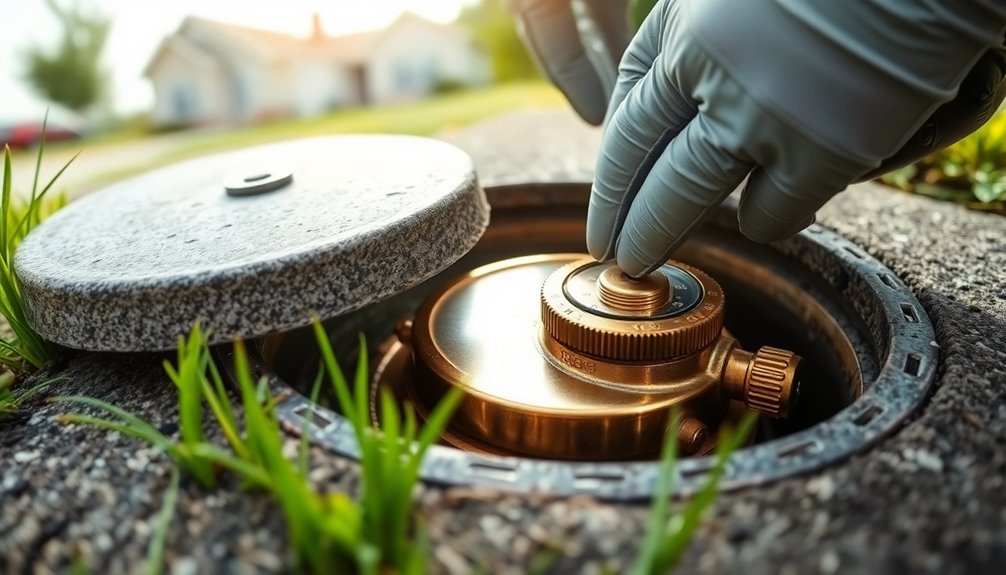
To open your water meter box, start by locating it, typically found in your front yard or near the curb, often marked with a "water" label.
Once you've found it, grab a screwdriver or an appropriate tool to carefully remove the lid. Be cautious, as wildlife may be hiding inside.
After you've lifted the lid, check if you have a digital meter or an analog one. If it's digital, you might need to activate a light to display the readings. For an analog meter, watch for the red sweep hand, which indicates your water consumption. Using tools like price comparison platforms can help you find better rates on water services or related products. Additionally, using Google Shopping can assist in comparing prices for water-saving devices to reduce your bills.
Before you plunge into checking your meter, make certain the area around the box is clear of debris. This will make accessing the meter easier for regular readings and any necessary repairs.
It's a good idea to regularly check the meter box to prevent overgrowth or obstruction, which could lead to a high water bill. Keeping this area maintained guarantees you can quickly assess your water usage and take action if something seems off. Additionally, leveraging price comparison tools can help you find better rates on water services or related products, ultimately aiding in budget management.
Reading Your Water Meter
Understanding your water meter's reading is essential for managing your water consumption effectively. By regularly checking your meter, you can keep track of your water usage and identify any unexpected spikes that may indicate leaks.
Here's how to read different types of water meters:
- Digital Meters: Simply locate the meter box and check the display for total water usage and flow rate in gallons.
- Analog Meters: Open the lens cover and observe the sweep hand. Each complete rotation signifies 10 gallons, while the total cubic feet since installation is visible on the dial.
- Round-Reading Meters: Read each dial clockwise, stopping at the cubic foot dial, which lacks numbers. Combine the recorded numbers to determine your total water usage.
Monitoring Your Water Usage
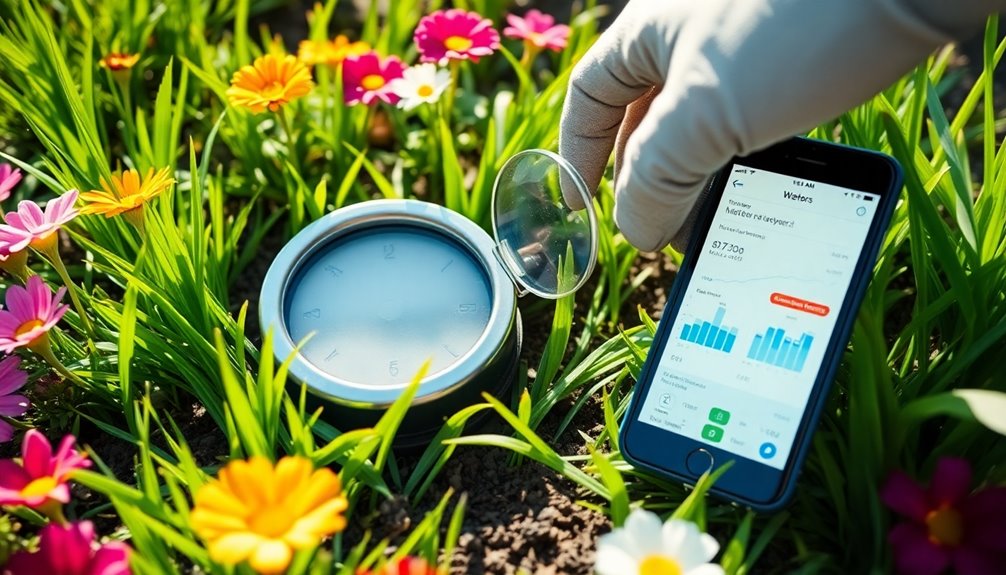
Monitoring your water usage regularly can help you spot any sudden increases that might signal a leak, saving you money in the long run.
By keeping a log of your readings, you'll identify patterns in your consumption and make informed adjustments.
Plus, modern digital meters make tracking usage easier than ever with convenient reporting features.
Benefits of Regular Monitoring
Regularly checking your water meter offers numerous advantages that can greatly impact both your wallet and the environment.
By keeping tabs on your daily household water usage, you can identify patterns and make adjustments that lead to savings. Monitoring your water meter helps you spot any unusual bill spikes, which could indicate a problem like a leak.
Benefits of regular monitoring include:
- Tracking flow rate: Understanding your flow rate helps you gauge your consumption accurately.
- Preventing unexpected costs: Early detection of leaks can save you from those surprising utility bills that can add up.
- Encouraging sustainable habits: Logging your water usage encourages you to adopt more responsible consumption patterns.
Detecting Leaks Early
Water leaks can be a homeowner's worst nightmare, silently draining resources and money. To catch leaks early, you need to regularly monitor your water usage. Start by turning off all water appliances in your home and recording the meter reading. If, after 20 minutes, the meter shows any flow, you likely have a leak.
Digital water meters often come with a leak indicator that alerts you to potential issues before they escalate into higher utility bills. It's wise to perform annual checks on your water meter to verify it's functioning correctly, preventing unexpected charges due to billing errors or malfunctions.
Keeping a log of your meter readings over time helps you become aware of your water consumption patterns. By tracking these amounts, you can easily spot unusual spikes that may indicate a leak.
Identifying Leaks Through Meter Readings
Your water meter can be a valuable tool for identifying leaks in your plumbing system. Regularly monitoring it can reveal unusual spikes in usage that may indicate leaks, which account for about 12% of water use in the U.S.
To check for leaks, turn off all taps and appliances, then observe the meter. If the flow rate shows greater than zero after 20 minutes, it suggests a leak is present.
Utilizing digital meters with a leak indicator can make this process even easier. When a leak is detected, these meters often display a flashing icon.
Here are some tips to help you effectively identify leaks:
- Keep a log of your meter readings over time to track usage trends.
- Perform annual checks on your water meter to verify accuracy.
- Monitor the number of cubic feet used regularly for any sudden changes.
Understanding Your Water Bill
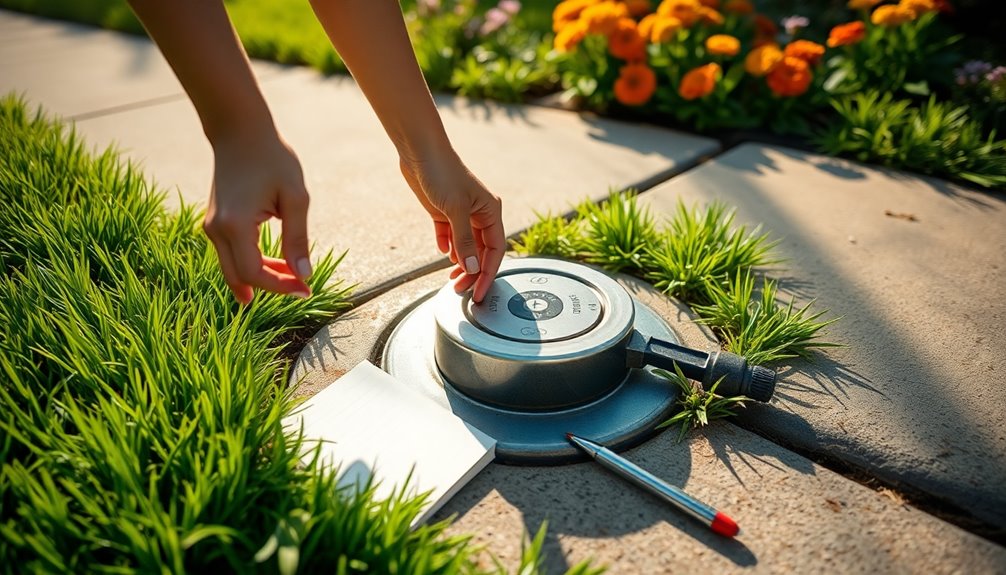
Understanding your water bill can feel overwhelming, but breaking it down into its components makes it easier to manage. Your bill typically reflects the total volume of water you've used, measured in gallons or cubic feet. Charges are usually based on tiered rates that increase with higher consumption levels, so knowing how much water you use can save you money.
Look closely at your bill to identify fixed charges, variable rates based on your usage, and any additional fees, such as those for sewer or stormwater management. Regularly monitoring your water meter helps you track your actual usage against the estimated charges, leading to better budgeting and cost management.
Be aware that leaks can inflate your bill considerably. In fact, undetected leaks may account for up to 12% of water use in the U.S. Timely leak detection and repairs are essential.
Finally, familiarize yourself with your utility provider's billing cycle and payment options. This knowledge can help you optimize payment timing, avoid late fees, and ultimately manage your overall water expenses more effectively.
Tips for Reducing Water Consumption
Reducing water consumption isn't only beneficial for the environment but can also lead to significant savings on your utility bill. By regularly monitoring your water meter, you can track your daily usage and identify patterns that highlight areas for potential savings.
Here are some practical tips to help you cut down on water consumption:
- Fix leaks promptly, as they account for about 12% of water use in the U.S.
- Install water-efficient fixtures like low-flow showerheads and faucets to reduce water usage without sacrificing performance.
- Adjust your irrigation schedule to water only when necessary, ideally during cooler parts of the day.
Additionally, consider using mulch in your gardens and landscaping. It helps retain soil moisture, which can reduce the frequency of watering and ultimately lower your water bill.
By implementing these strategies, you'll not only conserve low water but also lower your utility costs. Take control of your water use today by keeping an eye on your water meter and making these adjustments in your daily routine.
Every little bit helps!
Reporting Water Meter Issues
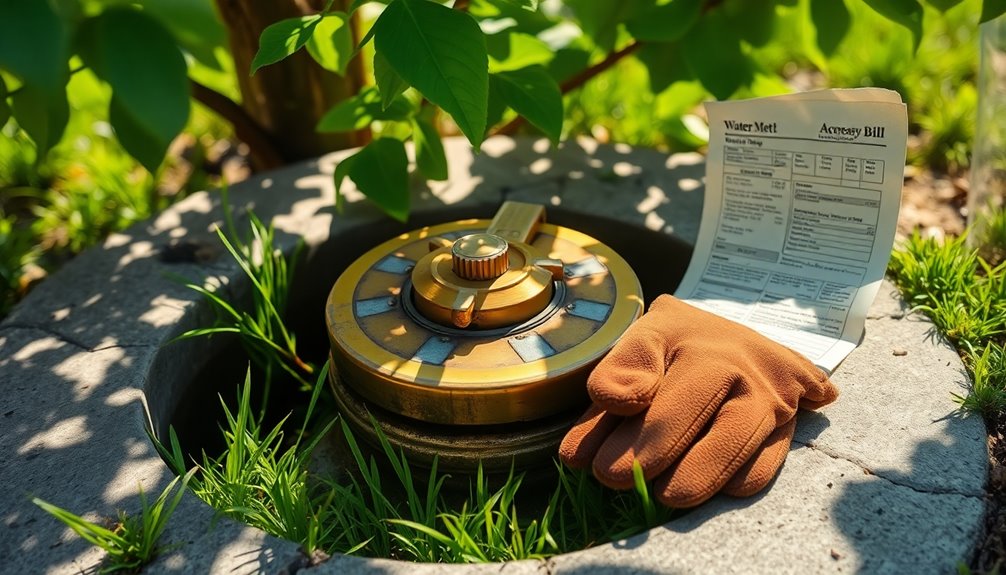
Detecting issues with your water meter is essential for maintaining accurate billing and efficient water use. If you notice discrepancies in your water bill, it may signal a malfunctioning meter that needs immediate attention.
Don't hesitate to report water meter issues to your water company for diagnosis and potential repair. Many companies provide free repairs if they find no signs of tampering, guaranteeing you're billed accurately.
To report issues, contact your water company directly. Be ready to provide details about the discrepancies and any meter readings you've noted. Regularly monitoring your meter can help you catch problems early. If you observe significant spikes in usage without any changes in your habits, report this promptly.
Most water companies offer customer portals or hotlines, making it easier and faster to address these concerns. By reporting water meter issues as soon as you spot them, you help guarantee that your water usage is accurately reflected in your bill.
This proactive approach not only saves you money but also promotes efficient water use in your home. Stay vigilant, and don't let inaccuracies in your billing go unaddressed!
Scheduling Meter Inspections
Scheduling regular inspections of your water meter is essential for ensuring accurate readings and spotting potential leaks early.
By arranging these inspections, you can prevent unexpected utility charges and maintain efficient water usage. Contact your water utility provider to set up a professional inspection, as they can identify issues and provide maintenance at no charge if no tampering is found.
To make the most of your scheduling inspections, consider the following:
- Annual Check-ups: Regular inspections can uncover discrepancies in your water usage that might lead to higher bills.
- Utilize Resources: Use your utility company's Customer Portal to inquire about scheduling inspections and access performance data for your water meter.
- Keep Records: Maintain a log of your meter readings over time to track usage patterns and detect any significant changes.
Additional Resources for Homeowners
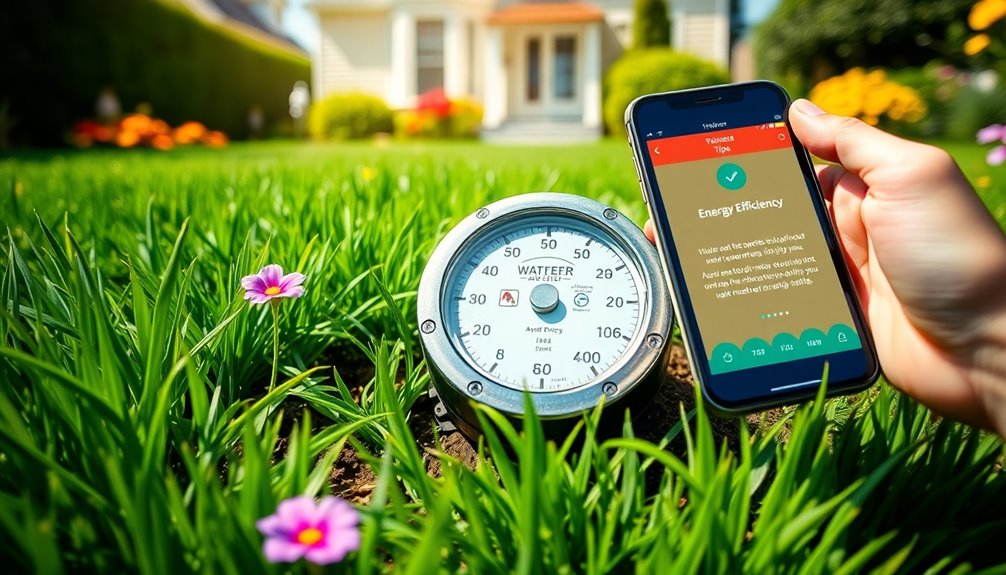
As a homeowner, having access to various resources can greatly enhance your ability to manage water usage and costs effectively. One of the most valuable tools at your disposal is the Customer Portal provided by your water company. Here, you can track your usage, inquire about your account, and get assistance directly from your provider.
If you're concerned about high water bills, the High Water Bill page offers practical tips and strategies to help you understand billing discrepancies and manage unexpected charges. Additionally, you can download the Leak Check document to learn how to identify potential leaks that might be inflating your bills.
If you've experienced unusually high charges due to a leak, check out the Leak Adjustment page for information on eligibility requirements and support options.
Also, don't forget about the "Call Before You Dig" service, which can help you avoid damaging water lines during outdoor projects.
Conclusion
In summary, knowing your water meter is like having a secret map to treasure—you can uncover potential savings and keep your bills in check. By locating your meter and understanding how it works, you're not just cutting costs; you're also nurturing the environment. So, take the plunge, reduce your consumption, and watch your utility bills shrink like a winter coat tossed aside in spring. With a little effort, you'll be swimming in savings!

